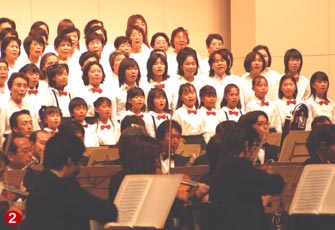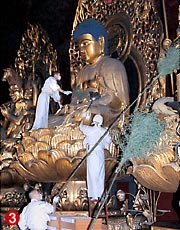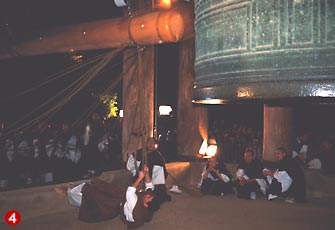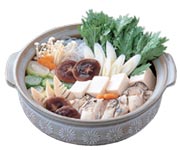 |
|
Performances of Beethoven's Ninth Symphony
"Ode to Joy," the fourth movement of Beethoven's Ninth Symphony, matches the hopes and mood of the season. Symphony performances are given in many cities each year in December. Just before the end of World War II, students who had to cut short their studies at a music university to go to war held farewell parties, where they sang the Ode. When the war ended, those who survived returned to Japan and got together for a reunion. There they sang the Ode again, in memory of their fallen comrades. This, apparently, is how the custom started. (Photo credit: Soka Municipal Government)
|
 |
|
Susu-harai (thorough cleaning)
Many homes do a thorough house cleaning around the end of the last month of the year. According to old tradition, the house is cleaned of a year's accumulation of dust, dirt and grime that had collected in hard-to-reach places. This got the home clean for the New Year festivities and kept bad luck away. The cleaning began around the 13th day of the last month.
Photo: On the 14th, monks climb up on the statue of Buddha and give it a thorough cleaning, at Nikkosan Rinno-ji Temple in Nikko, Tochigi Prefecture. (Photo credit: The Mainichi Newspapers Co.)
|
 |
|
O-misoka (New Year's Eve)
New Year's Eve is called o-misoka, or joya. At the stroke of midnight, kane bells at temples throughout the country ring out 108 times. This custom is called joya no kane. Why 108 times? To eliminate from listeners' hearts the 108 human failings, which include desire, possessiveness, anger and envy. The photo, taken at Chion-in Temple in Kyoto, shows the priest throwing his whole body back to propel the massive striker even harder against the bell. Before midnight, as tradition goes, families gather to eat toshi-koshi soba (buckwheat noodles representing the wish for a long life). Then it is time to celebrate the coming of the new year, and listen to the temple bells. (Photo credit: JTB photo)
|
|
 |
1st
Eiga no Hi (Cinema Day) |
| | |
 |
8th
Hari kuyo
Old or broken needles are stuck in tofu and mochi rice cakes, then taken to a temple or shrine. The needles, now useless through so much use, are offered up in a religious ritual, in the hope that the users will become even better at sewing. |
| | |
 |
Throughout the month
Bonen-kai (year-end parties)
One of the most enjoyable occasions for many—a time when alcohol flows freely, everyone takes boiled food from a shared pot (see photo below), and co-workers acknowledge each other's value as work colleagues. Friends also get together for similar parties. |
| | |
| |
 |
|
Photo credit:JTB photo |
|
| | |
| | Performances of Beethoven's Ninth Symphony (See photo and description) and description) |
| | |
 |
13th to the end of the month
Susu-harai(thorough cleaning) (See photo and description) and description) |
| | |
 |
14th
Akogishi-sai Festival, at Ako, Hyogo Prefecture |
| | |
 |
17th to 19th
Hago-ita Market, at Senso-ji Temple, Taito-ku, Tokyo
Hago-ita are decorated paddles for a traditional game. Fairs selling them are held throughout the country around the middle of the month. The annual market at Senso-ji Temple in Tokyo is especially famous, and enthusiasts come from all over the country to buy gorgeous, top-quality varieties. |
| | |
 |
21st (approximate)
Toji (winter solstice)
According to tradition, the year's shortest day and longest night should be celebrated by soaking in a yuzu (citron) hot bath, and eating squash. |
| | |
 |
23rd
Emperor's Birthday, national holiday |
| | |
 |
24th
Christmas Eve (See photo and description) and description) |
| | |
 |
25th
Christmas |
| | |
 |
31st
O-misoka(New Year's Eve)
(See photo and description) and description) | | | |
| |
Kohaku Uta Gassen
Japan's best-known singers and other invited guests get together for this TV extravaganza of song. The women's team (Aka-gumi, "The Reds") compete against the men's team (Shiro-gumi,"The Whites"). More than half of the country used to watch the program every New Year's Eve, although ratings have declined slightly over the last few years.
|
|






